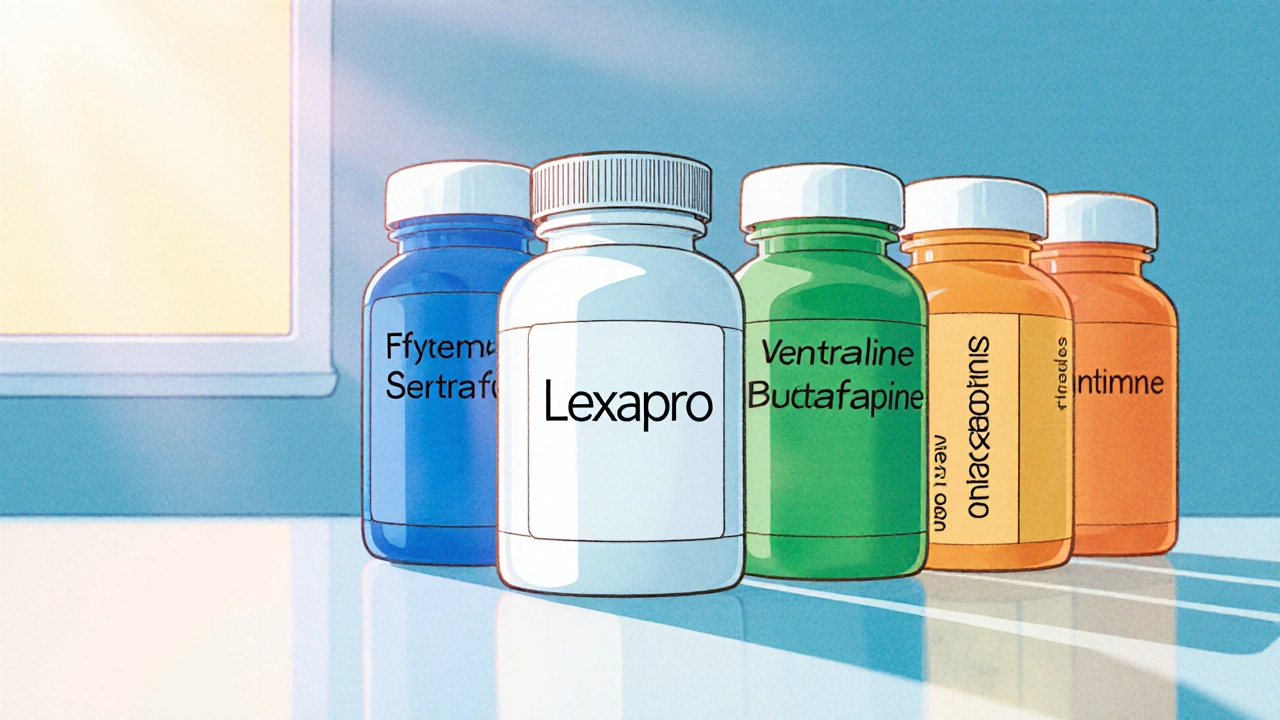Antidepressant Matching Tool
Find the antidepressant that best matches your needs
Answer these questions to see which antidepressants may be most suitable for you based on your symptoms and concerns.
When you’ve been prescribed Lexapro (brand name for Escitalopram) you’ll start wondering how it stacks up against other mood‑lifting meds. Below you’ll find a side‑by‑side look at the most common alternatives, real‑world dosing tips, and the trade‑offs that matter when choosing a daily pill.
Key Takeaways
- Lexapro is the most selective SSRI on the market, which often means fewer side effects but can still cause sexual dysfunction and weight changes.
- Older SSRIs like Fluoxetine (Prozac) have a longer half‑life, making withdrawal smoother but sometimes leading to insomnia.
- SNRIs such as Venlafaxine work on both serotonin and norepinephrine, offering stronger energy‑boosting effects for some patients.
- Atypical agents like Bupropion avoid sexual side effects but may raise seizure risk at high doses.
- Choosing the right antidepressant hinges on your symptom profile, past medication response, and how you handle side effects.
Why Compare Antidepressants?
Depression and anxiety are not one‑size‑fits‑all conditions. A drug that lifts one person’s mood might leave another feeling dizzy or apathetic. Comparing drugs helps you and your clinician pinpoint the medication that aligns with your lifestyle, health history, and personal preferences.
How We Compare
We’ll score each drug on six practical criteria:
- Mechanism of action - What neurotransmitters it targets.
- FDA approval year - Gives a hint about how long it’s been studied.
- Typical dose range - Helps you understand titration.
- Common side‑effect profile - Focus on weight change, sexual dysfunction, and sedation.
- Withdrawal risk - How hard it is to stop.
- Special considerations - Pregnancy, drug‑drug interactions, price.
If you’re weighing Lexapro against other options, this checklist will keep the conversation grounded in facts rather than anecdotes.
Quick Reference Table
| Drug | Class | Approval Year | Typical Dose | Weight Effect | Sexual Side‑effects | Withdrawal |
|---|---|---|---|---|---|---|
| Escitalopram (Lexapro) | SSRI | 2002 | 10‑20 mg daily | Neutral to slight gain | Moderate (≈30% patients) | Medium - 1‑2 weeks taper recommended |
| Fluoxetine (Prozac) | SSRI | 1987 | 20‑80 mg daily | Weight loss or neutral | Low to moderate | Low - long half‑life smoothes off |
| Sertraline (Zoloft) | SSRI | 1991 | 50‑200 mg daily | Neutral | Moderate | Medium |
| Venlafaxine (Effexor) | SNRI | 1993 | 37.5‑225 mg daily | Weight gain (dose‑dependent) | Low | High - abrupt stop can cause spikes |
| Duloxetine (Cymbalta) | SNRI | 2004 | 30‑120 mg daily | Weight gain (moderate) | Low | High |
| Bupropion (Wellbutrin) | Atypical | 1989 | 150‑450 mg daily | Weight loss or neutral | Rare | Low - no sexual dysfunction |
| Mirtazapine (Remeron) | Atypical | 1996 | 15‑45 mg nightly | Weight gain (common) | Low | Medium - sedation helps taper |
Deep Dive: Individual Drug Profiles
Lexapro (Escitalopram)
Escitalopram is the S‑enantiomer of citalopram, meaning it’s chemically pure and more selective for the serotonin transporter. This purity translates to a slightly higher response rate and fewer off‑target effects. Most patients start at 10 mg; clinicians can increase to 20 mg if needed. Common side effects include mild nausea, occasional insomnia, and a 30% chance of reduced libido. Because its half‑life is about 27 hours, a taper over 1‑2 weeks is advised to avoid discontinuation syndrome.
Fluoxetine (Prozac)
Fluoxetine has the longest half‑life among SSRIs (4‑6 days), making it forgiving for missed doses. It’s often chosen for patients with comorbid ADHD or for those who need an energizing effect. Weight loss or no change is typical, but some people experience insomnia, especially at higher doses. Its long washout period means withdrawal is rare, but it can take weeks for the drug to leave the system after stopping.
Sertraline (Zoloft)
Sertraline hits both serotonin and, to a lesser extent, dopamine pathways, which can help with anxiety‑dominant presentations. Starting doses are low (25 mg) to limit gastrointestinal upset. It’s considered weight‑neutral, though a small subset reports modest gain. Sexual dysfunction rates are similar to other SSRIs. Tapering over 1‑2 weeks is generally sufficient.
Venlafaxine (Effexor)
As an SNRI, venlafaxine lifts both serotonin and norepinephrine, giving a boost in energy and concentration. However, the drug’s blood‑pressure‑raising potential means regular monitoring for doses above 150 mg. Weight gain is more common than with pure SSRIs, and abrupt discontinuation can trigger flu‑like symptoms, so a slow taper (over several weeks) is essential.
Duloxetine (Cymbalta)
Duloxetine shares the SNRI profile but is also approved for chronic pain and diabetic neuropathy, making it a two‑in‑one option for patients with pain‑related depression. Side effects include dry mouth and occasional liver‑enzyme elevation, so liver function tests are recommended before starting. Like venlafaxine, it carries a higher withdrawal risk.
Bupropion (Wellbutrin)
Bupropion works by inhibiting the reuptake of norepinephrine and dopamine, skipping the serotonin system altogether. That’s why it rarely causes sexual side effects-something many patients appreciate. It can stimulate appetite suppression, leading to weight loss. The main safety concern is a dose‑related seizure risk, so it’s avoided in patients with a history of seizures or eating disorders.
Mirtazapine (Remeron)
Mirtazapine blocks certain serotonin receptors while enhancing norepinephrine release, producing a strong sedative effect. Doctors often prescribe it at night to help insomnia‑related depression. The trade‑off is significant weight gain for many patients, driven by increased appetite and metabolic changes. Its antihistamine action means it’s less likely to cause sexual dysfunction, and the sedation can ease tapering off of other stimulatory antidepressants.
Choosing the Right Fit: Decision Guide
Use the flow below to narrow down the best candidate for you.
- Do you need extra energy or focus?
-> Look at SNRIs (Venlafaxine, Duloxetine) or Bupropion. - Is weight change a major concern?
-> Lexapro, Fluoxetine, and Bupropion are the most weight‑neutral or weight‑loss friendly. - Are sexual side effects a deal‑breaker?
-> Bupropion and Mirtazapine rank lowest. - Do you have chronic pain?
-> Duloxetine or low‑dose Venlafaxine may hit two birds with one stone. - Is insomnia part of your picture?
-> Mirtazapine’s sedative profile or low‑dose Trazodone (off‑label) can help.
Talk through these points with your prescriber. They’ll weigh medical history, drug interactions, and insurance coverage before finalizing the prescription.
Cost & Access in 2025
Generic escitalopram is now widely available in Australia and the U.S., costing around $0.10‑$0.15 per tablet. Fluoxetine and sertraline generics are even cheaper (<$0.08). SNRIs like duloxetine tend to be pricier, often $0.30‑$0.45 per tablet unless covered by a government scheme. Bupropion’s price sits in the mid‑range. Remember to check your private health fund’s formulary; many cover the generic SSRIs first before approving SNRIs.
Potential Pitfalls & How to Avoid Them
- Skipping the titration phase. Jumping straight to a high dose can trigger nausea, agitation, or intense anxiety. Start low, increase slowly.
- Ignoring drug‑drug interactions. Some SSRIs inhibit CYP2D6, affecting beta‑blockers or certain anti‑epileptics. Use a medication review tool or ask a pharmacist.
- Stopping abruptly. Even “mild” antidepressants can cause dizziness, electric‑shock sensations, and mood swings if you quit cold turkey.
- Assuming one drug works forever. Depression can evolve; switching agents after 6‑8 weeks of adequate dosing is normal if response is insufficient.
Final Thoughts
There’s no universal “best” antidepressant. Lexapro’s clean SSRI profile makes it a solid first‑line choice for many, especially those sensitive to weight gain or sleep disturbances. However, alternatives like venlafaxine, duloxetine, or bupropion shine when you need extra energy, pain relief, or a side‑effect profile that avoids sexual dysfunction. Use the comparison table, weigh the decision criteria, and keep an open line with your clinician-your brain chemistry deserves a personalized plan.
What makes Lexapro different from generic citalopram?
Lexapro contains only the S‑enantiomer of citalopram, which binds more selectively to the serotonin transporter. This results in a slightly higher efficacy and lower incidence of side effects like QT‑prolongation compared with the racemic mix in citalopram.
Can I switch from Lexapro to an SNRI without a washout period?
Because Lexapro’s half‑life is about 27 hours, most clinicians recommend a brief overlap of 1‑2 days when moving to an SNRI like venlafaxine, then taper the SSRI over a week to reduce discontinuation symptoms.
Why do some people gain weight on antidepressants?
Weight changes stem from alterations in appetite, metabolism, and activity level. Drugs that boost serotonin (e.g., mirtazapine) can increase hunger, while those that raise norepinephrine (e.g., bupropion) often suppress appetite, leading to weight loss.
Is it safe to take Lexapro while pregnant?
Escitalopram is classified as Pregnancy Category C in the U.S., meaning risk cannot be ruled out. Doctors weigh the benefits of treating maternal depression against potential fetal exposure; often, a low dose is continued if the mother’s mental health would otherwise deteriorate.
How long does it take for Lexapro to start working?
Patients typically notice a reduction in anxiety within 1‑2 weeks, but full antidepressant effects may take 4‑6 weeks of consistent dosing.





Carolyn Cameron
In the grand tapestry of psychopharmacology, escitalopram occupies a singular niche, distinguished by its remarkable receptor selectivity and consequent favorable adverse-effect profile. The comparative data elucidated herein underscore its propensity for minimal weight fluctuation, a consideration of paramount significance for the discerning patient. Moreover, the drug's half‑life of approximately twenty‑seven hours affords a predictable pharmacokinetic curve, thereby facilitating a measured tapering regimen. One must, however, remain vigilant regarding the moderate incidence of sexual dysfunction, a phenomenon not to be dismissed lightly. In sum, Lexapro distinguishes itself through a confluence of efficacy, tolerability, and dosing convenience, rendering it a commendable first‑line agent.
Ben Durham
That’s a solid overview, and it’s worth noting the importance of starting at a low dose, typically ten milligrams, before titrating upward as needed. A cautious upward adjustment can help mitigate gastrointestinal upset, which some patients experience early on. Keeping a symptom diary can also be invaluable for both clinician and patient.
Chris L
From a collaborative standpoint, the synthesis of patient history with pharmacological nuances often guides the optimal selection. For individuals who value an energizing effect, SNRIs like venlafaxine may be advantageous, yet the attendant blood‑pressure monitoring cannot be overlooked. Conversely, patients prioritizing weight neutrality might gravitate toward escitalopram or bupropion, aligning with their lifestyle goals. The overall therapeutic alliance thrives when these considerations are transparently discussed.
Leah Ackerson
One could argue that the pursuit of the “right” antidepressant mirrors the Sisyphean quest for existential equilibrium-ever rolling, never quite arriving. 🌱 Yet, each medication offers a distinct hue on the emotional spectrum, inviting us to contemplate the fluidity of mood. 😌
Gary Campbell
While mainstream literature glorifies Lexapro as a benign solution, one must question the hidden agendas of pharmaceutical conglomerates. The rapid rollout of generic escitalopram coincided suspiciously with policy shifts favoring insurance cost‑containment, raising eyebrows about profit motives over patient welfare. Additionally, the subtle influence of these compounds on neuroplasticity may extend beyond therapeutic intent, potentially modulating societal conformity. It’s prudent to scrutinize the data layers and demand transparency from regulatory bodies.
Ramesh Kumar
Interesting points, and to add a friendly note, many clinicians emphasize that the benefits usually outweigh the theoretical risks when the medication is prescribed responsibly. Monitoring side effects and maintaining open communication can help navigate any unexpected outcomes.
Barna Buxbaum
Great discussion so far! Just a reminder that personal response can vary widely, so what works for one person might not work for another. It’s always a good idea to keep a simple log of mood changes, sleep patterns, and any side effects. That way, you and your prescriber can fine‑tune the treatment plan together.
asha aurell
Weight impact is often the deciding factor for many patients.
Charlene Gabriel
Embarking on the journey of antidepressant selection is akin to navigating a vast library of therapeutic literature, each chapter offering nuanced insight into the human psyche. First and foremost, it is essential to acknowledge that depression is not a monolithic disorder; it manifests in a kaleidoscope of symptoms that demand individualized attention. Lexapro, with its high selectivity for the serotonin transporter, often presents a favorable side‑effect spectrum, particularly concerning weight stability and a moderate sexual dysfunction profile. However, for patients whose predominant concerns revolve around lethargy and concentration deficits, an SNRI such as venlafaxine or duloxetine may provide the requisite norepinephrine boost, albeit with increased vigilance for blood pressure elevations. Conversely, individuals plagued by the distress of sexual side effects might find solace in bupropion, which circumvents the serotonergic pathway entirely. It is also prudent to consider the pharmacokinetic properties; fluoxetine’s extended half‑life can smooth the turbulence of withdrawal but may prolong the presence of residual effects. Moreover, the economic dimension cannot be ignored: generic escitalopram has become increasingly affordable, yet insurance formularies sometimes favor older agents, influencing accessibility. One must also weigh the impact of comorbid conditions; for example, duloxetine’s efficacy in chronic pain conditions can serve a dual purpose, alleviating both somatic and affective symptoms. It is also prudent to consider the pharmacokinetic properties; fluoxetine’s extended half‑life can smooth the turbulence of withdrawal but may prolong the presence of residual effects. Moreover, the economic dimension cannot be ignored: generic escitalopram has become increasingly affordable, yet insurance formularies sometimes favor older agents, influencing accessibility. One must also weigh the impact of comorbid conditions; for example, duloxetine’s efficacy in chronic pain conditions can serve a dual purpose, alleviating both somatic and affective symptoms. In pediatric populations, the safety profile and dosing flexibility become paramount, guiding clinicians toward medications with established pediatric data. Pregnancy introduces another layer of complexity, as teratogenic risks and neonatal adaptation syndromes must be meticulously evaluated. The role of adjunctive psychotherapy remains a cornerstone, regardless of pharmacologic choice, reinforcing coping strategies and resilience. Clinical monitoring should encompass not only symptom remission but also periodic assessment of liver function, renal parameters, and metabolic indices where appropriate. Importantly, patient preference and shared decision‑making empower individuals, fostering adherence and satisfaction with the therapeutic regimen. In sum, the art of matching an antidepressant to a patient involves a symphony of clinical evidence, pharmacological insight, and compassionate dialogue, each note resonating to restore balance and hope.
renee granados
Remember, the cheap generics sometimes hide undisclosed fillers that could trigger hidden reactions. Stay alert and ask your pharmacist for the full ingredient list.
Stephen Lenzovich
Our nation's commitment to mental health must not be diluted by imported med‑talk that undermines American ingenuity. Lexapro, developed with rigorous domestic research, exemplifies the pinnacle of our pharmaceutical excellence. While foreign brands tout lower prices, they often compromise on quality, risking the very wellbeing of our citizens. It is incumbent upon us to champion home‑grown solutions that reflect our values of resilience and self‑reliance. In doing so, we preserve the integrity of our healthcare system and honor the sacrifices of those who built it.
abidemi adekitan
What a vibrant tapestry you’ve woven, my friend! Let’s sprinkle a dash of optimism into the mix: imagine each dose as a brushstroke painting a brighter tomorrow, each side‑effect merely a fleeting shadow that fades as the masterpiece unfolds.
laura balfour
Oh wow, that's sooo inspirng! I can totally see the picture you're painting-like a sunrise over a moody sea, with soulds uplifted and hearts beatin faster. Just a little note: watch out for those "typos" in med labeles, they can be a sneaky trap! But overall, keep that fire alight, and let the journey be as epic as a saga writen in the stars.